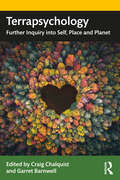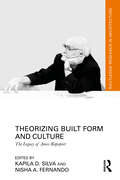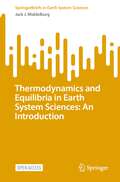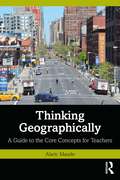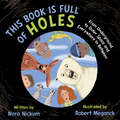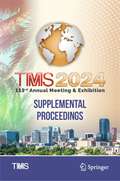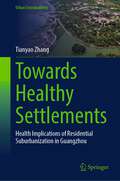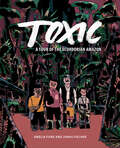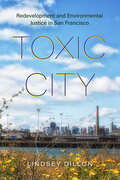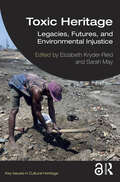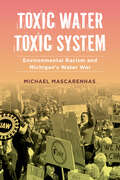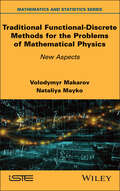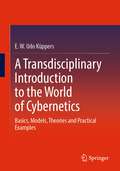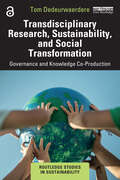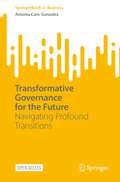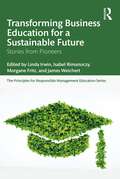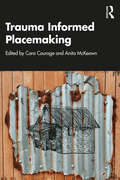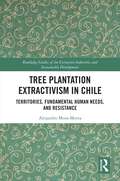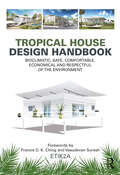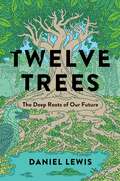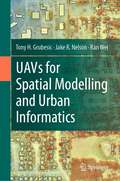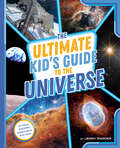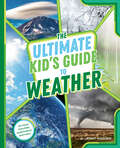- Table View
- List View
Terrapsychology: Further Inquiry into Self, Place and Planet
by Craig Chalquist Garret Barnwell- The place of nature and environment is increasingly recognized in therapeutic theory and practice. - Co-edited by the originator of the theory of Terrapsychology. - Builds on his successful 2020 title, Terrapsychological Inquiry, which we also published.
Theorizing Built Form and Culture: The Legacy of Amos Rapoport (Routledge Research in Architecture)
by Kapila D. Silva Nisha A. FernandoIn this collection of essays, Theorizing Built Form and Culture: The Legacy of Amos Rapoport – a felicitation volume to celebrate the significance of Professor Amos Rapoport's lifelong scholarship – scholars from around the world discuss the analytical relevance, expansion, and continuing application of these contributions in developing an advanced understanding of mutual relationships between people and built environments across cultures.Professor Amos Rapoport has espoused an intellectual and theoretical legacy on environmental design scholarship that explains how cultural factors play a significant role in the ways people create and use environments as well as the way environments, in turn, influence people’s behavior. This volume presents a hitherto-not-seen, unique, and singular work that simultaneously articulates a cohesive framework of Rapoport’s architectural theories and demonstrates how that theoretical approach be used in architectural inquiry, education, and practice across environmental scales, types, and cultural contexts. It also acknowledges, for the very first time, how this theoretical legacy has pioneered the decolonizing of the Eurocentric approaches to architectural inquiry and has thus privileged an inclusive, cross-cultural perspective that laid the groundwork to understand and analyze non-Western design traditions. The book thus reflects a wide range of cross-cultural and cross-contextual range to which Professor Rapoport’s theories apply, a general notion of theoretical validity he always advocated for in his own writings.The volume is a paramount source for scholars and students of architecture who are interested in understanding how culture mediates the creation, use, and preservation of the built environment.
Thermodynamics and Equilibria in Earth System Sciences: An Introduction (SpringerBriefs in Earth System Sciences)
by Jack J. MiddelburgThermodynamics is needed to understand many processes on Earth, be they physical, chemical, or biological. Thermodynamics is critical to study the atmosphere (lapse rate, fohn winds, circulation), hydrosphere (latent and sensible heat, pressure dependence of freezing/boiling points), geosphere (geothermal gradients, mineral stability) and the biosphere (redox zonation, evolution of biogeochemical cycles). This introduction to thermodynamics and equilibria aims to provide the basic concepts of relevance for atmospheric, marine, climate, and environmental sciences and to prepare students for more advanced classes in physical chemistry, mineralogy, and petrology.This is an open access book.
Thinking Geographically: A Guide to the Core Concepts for Teachers
by Alaric MaudeThis book explains how the concepts of geography can teach young people to think geographically, deeply and ethically. Thinking Geographically demonstrates how the concepts of place, space, environment and interconnection teach students new ways of perceiving and understanding the world, the concepts of scale and time teach them ways of analysing the world, while the concepts of sustainability and wellbeing show them how to evaluate and reflect on what they observe, and all eight concepts develop their higher order and critical thinking. To further support teachers, this book includes a chapter on how to teach for conceptual understanding, as well as two chapters that illustrate the application of geographical thinking to an understanding of the effects of land cover change and the problem of regional inequality. Rich with practical examples, this book is an essential resource for geography teachers, whether already teaching or studying to become one, and for those who teach therm.
This Book Is Full of Holes: From Underground to Outer Space and Everywhere In Between
by Nora NickumThis book is chock full of holes—shallow and miles deep, microscopic and visible from space, human-caused and natural, mysterious and maddeningly familiar.When you think of holes, what comes to mind? Maybe the irritating hole in your sock. Or the hole on the shelf where you plucked out this book. But did you know there are holes that suddenly devour entire gas stations? Big holes in the ocean that are visible from space? Small holes in balls that prevent a backyard home run? A hole is a part of something where there&’s nothing at all. Holes are investigated by scientists, used by artists, designed by engineers, and fixed by problem-solvers. They can be natural or human-made, big or small, plentiful or scarce, mysterious or painfully familiar. Many are important to our everyday lives, whether we give them credit or not.A Junior Library Guild Gold Standard Selection
TMS 2024 153rd Annual Meeting & Exhibition Supplemental Proceedings (The Minerals, Metals & Materials Series)
by The Minerals, Metals & Materials SocietyThis collection presents papers from the 153rd Annual Meeting & Exhibition of The Minerals, Metals & Materials Society.
Total Garbage: How We Can Fix Our Waste and Heal Our World
by Edward HumesAn investigative narrative that dives into the waste embedded in our daily lives—and shows how individuals and communities are making a real difference for health, prosperity, quality of life and the fight against climate change, by a Pulitzer Prize winning journalistWhat happens to our trash? Why are our oceans filling with plastic? Do we really waste 40 percent of our food 65 percent of our energy? Waste is truly our biggest problem, and solving our inherent trashiness can fix our economy, our energy costs, our traffic jams, and help slow climate change—all while making us healthier, happier and more prosperous. This story-driven and in-depth exploration of the pervasive yet hard-to-see wastefulness that permeates our daily lives illuminates the ways in which we've been duped into accepting absolutely insane levels of waste as normal. Total Garbage also tells the story of individuals and communities who are finding the way back from waste, and showing us that our choices truly matter and make a difference. Our big environmental challenges – climate, energy, plastic pollution, deforestation, toxic emissions—are often framed as problems too big for any one person to solve. Too big even for hope. But when viewed as symptoms of a single greater problem—the epic levels of trash and waste we produce daily--the way forward is clear. Waste is the one problem individuals can positively impact—and not just on the planet, but also on our wallets, our health, and national and energy security. The challenge is seeing our epic wastefulness clearly. Total Garbage will shine a light on the absurdity of the systems that all of us use daily and take for granted--and it will help both individuals and communities make meaningful changes toward better lives and a cleaner, greener world.
Towards Healthy Settlements: Health Implications of Residential Suburbanization in Guangzhou (Urban Sustainability)
by Tianyao ZhangThis book aims to formulate recommendations for achieving a healthy neighborhood living environment for the middle-income people in China‘s suburbs. In China, the expeditious urbanization triggers the prosperous commodity housing development, which further grows with the spatial restructuring and socioeconomic transition. Residential suburbanization is generated, accompanied with the emergence of new-middle class and the change of lifestyle. However, the health effects of suburbanization in China are overlooked. This book investigates the health performance of suburban residents and the effects of suburban living on residents‘ health. This book also examines the resident-environment transaction modes to unfold the underlying mechanism of suburban living affecting residents’ health. Suburban residents had to passively adapt to their residential environment, which is the obstacle for achieving a health-promoting environment. The institutional dynamics determining the health performance of suburban living environment were addressed with the roles of governments, developers, planners, housing managers, residents‘ committee, and ordinary residents in commodity housing development. The book found no institutional support for the creation of health-promoting environments, especially with default of governments and excessive dependence on developers for public service facilities and the absence of civil society. Thus, the book proposes that institutional innovations are necessary in term of embedding the health dimension in all sectors of the society, enlisting collaboration between public and private sectors, and between health and non-health sectors, and thus cultivating the optimization of residents-environment transactions to create health-promoting environments.
Toxic: A Tour of the Ecuadorian Amazon (ethnoGRAPHIC)
by Amelia Fiske Jonas FischerOver the past decade, people have learned about oil contamination in the Ecuadorian Amazon through toxic tours in which a guide brings participants – students, lawyers, environmental activists, journalists, and foreign tourists – to visit contaminated sites. These toxic tours combine personal experience and local knowledge to convince visitors of the immediacy of environmental issues. Drawing on extensive research and fieldwork, Toxic takes the reader on a visual toxic tour through the Amazon. Following the story of three fictional participants, this graphic novel paints a visceral picture of the waste pits, gas flares, and precarious lives of people in this region. The book challenges the reader to consider what it means to live in a place and historical moment where victims of industrial toxicants are continually required to prove that harm has occurred. Toxic is a vivid reflection on the role of pollutants in our everyday lives, ultimately asking readers to reflect on how we are each implicated in the production, consumption, and exposure of pollution both in the Amazon and at home.
Toxic City: Redevelopment and Environmental Justice in San Francisco
by Lindsey DillonToxic City presents a novel critique of postindustrial green gentrification through a study of Bayview-Hunters Point, a historically Black neighborhood in San Francisco. As cities across the United States clean up and transform contaminated waterfronts and abandoned factories into inviting spaces of urban nature and green living, working-class residents—who previously lived with the effects of state abandonment, corporate divestment, and industrial pollution—are threatened with displacement at the very moment these neighborhoods are cleaned, greened, and revitalized. Lindsey Dillon details how residents of Bayview-Hunters Point have fought for years for toxic cleanup and urban redevelopment to be a reparative process and how their efforts are linked to long-standing struggles for Black community control and self-determination. She argues that environmental racism is part of a long history of harm linked to slavery and its afterlives and concludes that environmental justice can be conceived within a larger project of reparations.
Toxic Heritage: Legacies, Futures, and Environmental Injustice (Key Issues in Cultural Heritage)
by Elizabeth Kryder-Reid Sarah MayToxic Heritage addresses the heritage value of contamination and toxic sites and provides the first in-depth examination of toxic heritage as a global issue. Bringing together case studies, visual essays, and substantive chapters written by leading scholars from around the world, the volume provides a critical framing of the globally expanding field of toxic heritage. Authors from a variety of disciplinary perspectives and methodologies examine toxic heritage as both a material phenomenon and a concept. Organized into five thematic sections, the book explores the meaning and significance of toxic heritage, politics, narratives, affected communities, and activist approaches and interventions. It identifies critical issues and highlights areas of emerging research on the intersections of environmental harm with formal and informal memory practices, while also highlighting the resilience, advocacy, and creativity of communities, scholars, and heritage professionals in responding to the current environmental crises. Toxic Heritage is useful and relevant to scholars and students working across a range of disciplines, including heritage studies, environmental science, archaeology, anthropology, and geography.
Toxic Water, Toxic System: Environmental Racism and Michigan's Water War
by Prof. Michael MascarenhasThe tireless resistance of local communities fighting for ownership of America’s third largest water system Toxic Water, Toxic System exposes the consequences of a seemingly anonymous authoritarian state willing to maintain white supremacy at any cost—including poisoning an entire city and shutting off water to thousands of people. Weaving together narratives of frontline activists along with archival data, Michael Mascarenhas provides a powerful exploration of the political alliances and bureaucratic mechanisms that uphold inequality. Drawing from three years of ethnographic fieldwork in Flint and Detroit, this book amplifies the voices of marginalized communities, particularly African American women, whose perspectives and labor have been consistently overlooked. Toxic Water, Toxic System offers a fresh perspective on the ties between urban austerity policies, environmental harm, and the advancement of white supremacist agendas in predominantly Black and brown cities.
Traditional Functional-Discrete Methods for the Problems of Mathematical Physics: New Aspects
by Volodymyr Makarov Nataliya MaykoThis book is devoted to the construction and study of approximate methods for solving mathematical physics problems in canonical domains. It focuses on obtaining weighted a priori estimates of the accuracy of these methods while also considering the influence of boundary and initial conditions. This influence is quantified by means of suitable weight functions that characterize the distance of an inner point to the boundary of the domain. New results are presented on boundary and initial effects for the finite difference method for elliptic and parabolic equations, mesh schemes for equations with fractional derivatives, and the Cayley transform method for abstract differential equations in Hilbert and Banach spaces. Due to their universality and convenient implementation, the algorithms discussed throughout can be used to solve a wide range of actual problems in science and technology. The book is intended for scientists, university teachers, and graduate and postgraduate students who specialize in the field of numerical analysis.
A Transdisciplinary Introduction to the World of Cybernetics: Basics, Models, Theories and Practical Examples
by E. W. KüppersThis introduction to the world of cybernetics provides the basics and discusses the most important thought leaders, models as well as theories. Practical examples from the fields of biology, ecology, technology, society, and politics are used to illustrate the theoretical material. Questions at the end of the chapters stimulate reflection, and the author does not owe the answers. A central theme in all cybernetic considerations and a guiding theme of the book are information exchange and communication.
Transdisciplinary Research, Sustainability, and Social Transformation: Governance and Knowledge Co-Production (Routledge Studies in Sustainability)
by Tom DedeurwaerdereThis book addresses the gap in the existing literature on the governance of transdisciplinary research partnerships in transformational sustainability research by exploring the governance of knowledge co-production in coupled socio-ecological system dynamics. Multiple social and ecological crises raise new cross-sectoral research questions that call for an evolution in contemporary science in the direction of society-wide knowledge co-production on sustainability transformations of interdependent social and ecological systems. This book proposes a new approach to this based on enabling capacities for collaboration among scientific researchers and societal actors with diverse values, perspectives, and research interests. By drawing upon the thriving literature on the conditions for community and multistakeholder-driven collective action, the analysis sheds new light on the governance arrangements for organizing so-called transdisciplinary research partnerships for sustainability. This book identifies robust conditions that lead to effective collaborative research with societal actors and digs deeper into capacity building for partnership research through fostering social learning on sustainability values among research partners and organizing training and knowledge exchange at institutions of higher education. The book proposes solutions for addressing collective action challenges in transdisciplinary partnerships in an accessible and broadly interdisciplinary manner to a large audience of sustainability scholars and practitioners. It will be of interest to students and researchers in the fields of sustainable development, social ecological transitions, and science policy, while also being a useful resource for engineers, QSE managers, and policymakers.
Transdisciplinary Research, Sustainability, and Social Transformation: Governance and Knowledge Co-Production (Routledge Studies in Sustainability)
by Tom DedeurwaerdereThis book addresses the gap in the existing literature on the governance of transdisciplinary research partnerships in transformational sustainability research by exploring the governance of knowledge co-production in coupled socio-ecological system dynamics.Multiple social and ecological crises raise new cross-sectoral research questions that call for an evolution in contemporary science in the direction of society-wide knowledge co-production on sustainability transformations of interdependent social and ecological systems. This book proposes a new approach to this based on enabling capacities for collaboration among scientific researchers and societal actors with diverse values, perspectives, and research interests. By drawing upon the thriving literature on the conditions for community and multistakeholder-driven collective action, the analysis sheds new light on the governance arrangements for organizing so-called transdisciplinary research partnerships for sustainability. This book identifies robust conditions that lead to effective collaborative research with societal actors and digs deeper into capacity building for partnership research through fostering social learning on sustainability values among research partners and organizing training and knowledge exchange at institutions of higher education.The book proposes solutions for addressing collective action challenges in transdisciplinary partnerships in an accessible and broadly interdisciplinary manner to a large audience of sustainability scholars and practitioners. It will be of interest to students and researchers in the fields of sustainable development, social ecological transitions, and science policy, while also being a useful resource for engineers, QSE managers, and policymakers.The Open Access version of this book, available at http://www.taylorfrancis.com, has been made available under a Creative Commons Attribution-Non Commercial-No Derivatives (CC-BY-NC-ND) 4.0 license.
Transformative Governance for the Future: Navigating Profound Transitions (SpringerBriefs in Business)
by Antonia Caro-GonzalezThis open access book helps actors who are committed to change unlock true innovative potential for the common good in their organizations. Innovation and change processes are not linear. Hence, this book presents a novel way to manage complexity. The author introduces readers to a comprehensive change management framework, the Eoh-for-Good blueprint methodology. It presents the method and discusses how it can be used to support collaboration, overcome challenges and achieve lasting changes in organizations with a 360-degree approach combining top-down, middle-round and bottom-up collaborative perspectives.
Transforming Business Education for a Sustainable Future: Stories from Pioneers (The Principles for Responsible Management Education Series)
by Linda Irwin Isabel Rimanoczy Morgane Fritz James WeichertAs the impact of climate change becomes more evident and dire, business leaders, educators, students, and academic leaders are deciding what they need to change and do to survive and thrive in a new and dramatically different environment. This book sets out how to transform business education and integrate sustainability practices into curriculum and a wider academic culture. While some universities around the globe are still teaching business practices that have contributed to human and environmental crises, pioneering educators and higher education institutions are researching, developing, and implementing programs to transform business education and practices. With stories from 26 administrators, researchers, and faculty across the globe, this book inspires business educators with innovative tools and creative solutions to address challenges in the business world and society. These pioneers are helping students and business ventures change the way they conduct business to survive and thrive in a fast-changing global environment. Their unique and personal journeys offer tools, models, lessons-learned, and inspiration for change. The book will both inspire and guide faculty members, administrators, students, and alumni to transform business education for a sustainable future.
Trauma Informed Placemaking
by Courage, Edited by Cara Anita McKeownTrauma Informed Placemaking offers an introduction to understanding trauma and healing in place. It offers insights that researchers and practitioners can apply to their place-based practice, learning from a global cohort of place leaders and communities.The book introduces the ethos and application of the trauma-informed approach to working in place, with references to historical and contemporary trauma, including trauma caused by placemakers. It introduces the potential of place and of place practitioners to heal. Offering 20 original frameworks, toolkits and learning exercises across 33 first- and third-person chapters, multi-disciplinary insights are presented throughout. These are organised into four sections that lead the reader to an awareness of how trauma and healing operate in place. The book offers a first gathering of the current praxis in the field – how we can move from trauma in place to healing in place – and concludes with calls to action for the trauma-informed placemaking approach to be adopted.This book will be essential reading for students, researchers and practitioners interested in people and places, from artists and architects, policy makers and planners, community development workers and organisations, placemakers, to local and national governments. It will appeal to the disciplines of human geography, sociology, politics, cultural studies, psychology and to placemakers, planners and policymakers and those working in community development.
Tree Plantation Extractivism in Chile: Territories, Fundamental Human Needs, and Resistance (Routledge Studies of the Extractive Industries and Sustainable Development)
by Alejandro Mora-MottaThis book examines how extractivism transforms territories and affects the well-being of rural people, drawing on in-depth fieldwork conducted on tree plantations in Chile.The book argues that pine and eucalyptus monoculture plantations in southern Chile are a form of extractivism representing a mode of nature appropriation that captures large amounts of natural resources to produce wooden-based raw materials with little processing and an export-oriented focus. The book discusses the nexus of extractivism, territorial transformations, well-being, and emerging resistances using a participatory action research methodological approach in the Region of Los Ríos, southern Chile. The findings show how the configuration of an extractivist logging enclave generated a substantial and irrevocable reordering of human-nature relations, resulting in the territorial and ontological occupation of rural places that disrupted the fundamental human needs of peasants and indigenous people. The book maintains that Chile's green growth development approach does not challenge the consolidated tree plantation enclave controlled by large multinationals. Instead, green growth legitimises the extractivist logic. The book draws parallels with other countries and regions to contribute to wider debates surrounding these topics.This book will be of great interest to students and scholars of the extractive industries, development studies, political ecology, and natural resource governance.
Tropical House Design Handbook: Bioclimatic, Safe, Comfortable, Economical and Respectful of the Environment
by Etik2aPacked with accessible information, this book covers all the technical and practical aspects of home design in tropical environments. . It begins by outlining the prerequisites needed to understand the issues involved (climate, heat, thermal comfort, etc.) and discusses the solutions offered by traditional housing. It then identifies current solutions for protecting buildings and their occupants from solar radiation and external heat, while promoting bioclimatic and environmentally friendly approaches. . The economic viability of the solutions identified is discussed, as are the advantages and disadvantages of the materials, depending on the context and standards in force. . Numerous examples illustrate how buildings can be adapted to local realities, from the avant-garde creations of Jean Prouvé to those of today’s architects who are committed to sustainable development, as well as specific projects incorporating the recommendations made in this book. More than 460 photos, drawings, diagrams, tables, maps, house plans, logos and pictograms illustrate this reference work for all those involved in construction in tropical regions, particularly students in the field and, more generally, anyone – from professionals to private individuals – looking for useful information on this subject.
Twelve Trees: The Deep Roots of Our Future
by Daniel LewisA compelling global exploration of nature and survival as seen via a dozen species of trees that represent the challenges facing our planet, and the ways that scientists are working urgently to save our forests and our future.The world today is undergoing the most rapid environmental transformation in human history—from climate change to deforestation. Scientists, ethnobotanists, indigenous peoples, and collectives of all kinds are closely studying trees and their biology to understand how and why trees function individually and collectively in the ways they do. In Twelve Trees, Daniel Lewis, curator and historian at one of the world&’s most renowned research libraries, travels the world to learn about these trees in their habitats. Lewis takes us on a sweeping journey to plant breeding labs, botanical gardens, research facilities, deep inside museum collections, to the tops of tall trees, underwater, and around the Earth, journeying into the deserts of the American west and the deep jungles of Peru, to offer a globe-spanning perspective on the crucial impact trees have on our entire planet. When a once-common tree goes extinct in the wild but survives in a botanical garden, what happens next? How can scientists reconstruct lost genomes and habitats? How does a tree store thousands of gallons of water, or offer up perfectly preserved insects from millions of years ago, or root itself in muddy swamps and remain standing? How does a 5,000-year-old tree manage to live, and what can we learn from it? And how can science account for the survival of one species at the expense of others? To study the science of trees is to study not just the present, but the story of the world, its past, and its future. Note—species include: * The Lost Tree of Easter Island (Sophora toromiro) * The coast redwood (Sequoia sempervirens) * Hymenaea protera [a fossil tree] * The Longleaf pine (Pinus palustris) * East Indian sandalwood (Santanum album) * The Bristlecone pine (Pinus longaeva) * West African ebony (Diospyros crassiflora) * The Tasmanian blue gum eucalyptus (Eucalyptus globulus) * Olive tree (Olea europaea) * Baobab (Adansonia digitata) * the kapok tree (Ceiba pentandra) * The bald cypress (Taxodium distichum)
UAVs for Spatial Modelling and Urban Informatics
by Tony H. Grubesic Jake R. Nelson Ran WeiThis book aims to provide a wide range of real-world applications in using unmanned aerial vehicles (UAVs) for geographic observation, spatial modeling, and urban informatics. Specifically, UAVs are incredibly effective platforms for connecting people, places, and technology. This book explores the utility of UAVs for monitoring, measuring, and improving urban infrastructure systems, urban sustainability, and the urban environment. The dynamism of cities provides opportunities for economic, social, and environmental change, but benchmarking and measuring cities continues to be challenging. This challenge is due, at least in part, to a lack of monitoring systems that can collect and analyze data at a granular enough scale to capture the nuance of local phenomena. UAVs offer a promising mechanism to fill this niche, serving as a measurement platform that can rapidly and inexpensively collect data and monitor change in cities. However, their use is fraught with social, operational, regulatory, and technical challenges for successful deployments. This book provides a resource for urbanists (e.g., planners, geographers, sociologists, epidemiologists, engineers), educators, and students who work with geographic information and seek to enhance these data using data and information from unmanned aerial vehicles. At the same time, we provide operational and methodological frameworks for carrying out these advanced analyses in a manner that considers the challenges of incorporating UAVs in research within the urban environment. We provide six unique applications of UAVs for urban analysis, detailing relevant policy and empirical questions, UAV mission parameters, data collection, spatial modeling, and the associated empirical results. Further, we discuss how best to integrate these results into actionable geospatial intelligence and policy development to improve city infrastructure systems, sustainability, the environment, and neighborhood quality.
The Ultimate Kid's Guide to the Universe: At-Home Activities, Experiments, and More! (The Ultimate Kid's Guide to...)
by Jenny MarderWith stunning photos of outer space and easy at-home experiments, this is the only guide kids need on their journey of learning about all things astronomy: the stars, the planets, the moon, and so much more!Buckle up and let Jenny Marder, a senior writer for NASA, be your guide to the universe! First stop: the moon!A perfect read for kids, just in time for the April 2024 total solar eclipse!
The Ultimate Kid's Guide to Weather: At-Home Activities, Experiments, and More! (The Ultimate Kid's Guide to...)
by Jenny MarderWith stunning photos of Earth's wildest weather and easy at-home STEM activities, this is the only guide kids need on their journey of learning about all things meteorology.Buckle up and let Jenny Marder, a senior writer for NASA, be your guide through the Earth&’s atmosphere! First stop: the stratosphere!
